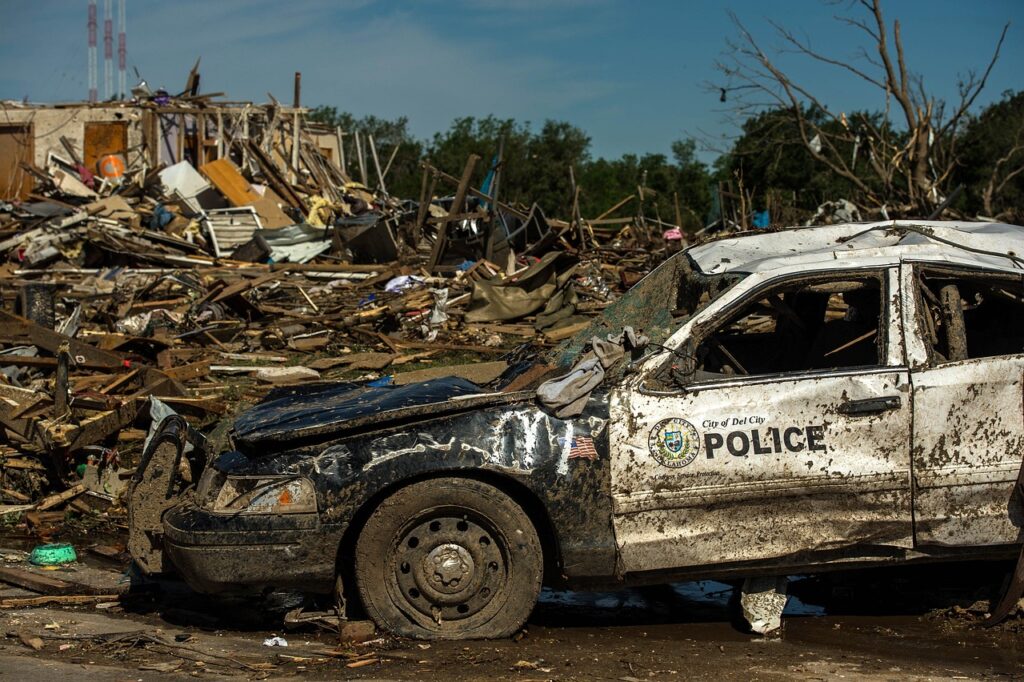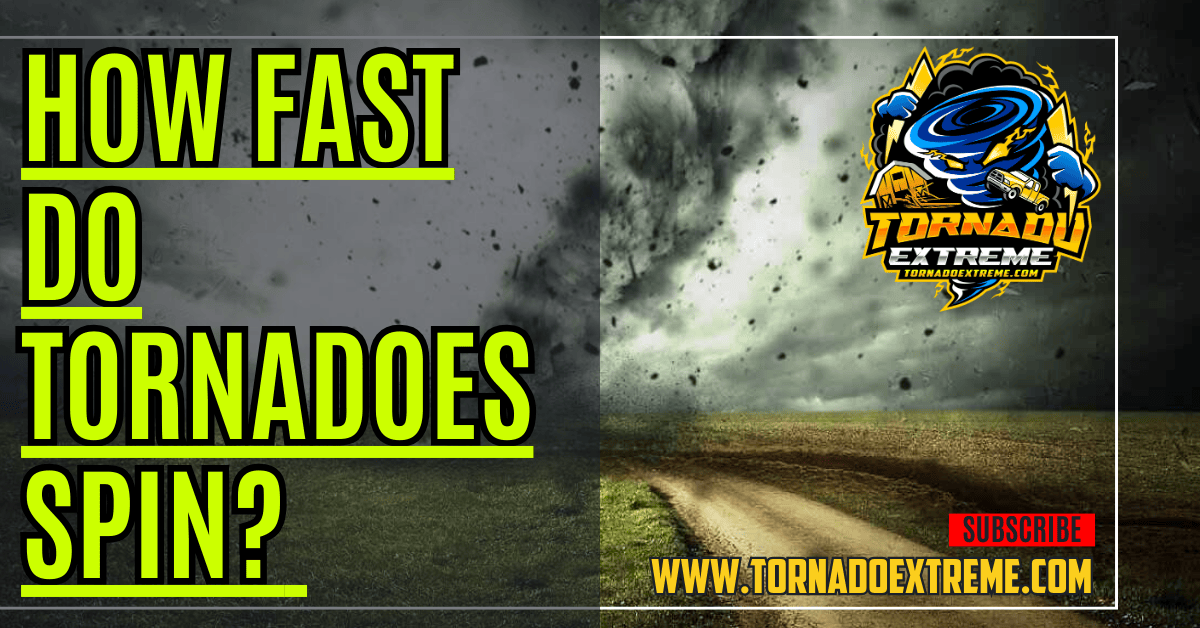Introduction to tornadoes
Tornadoes are a common natural occurrence in the world, but there are only so many places you’d find one. This destructive twister is mostly known for its time spent in the United States. When it comes to keeping up with tornadoes, the National Weather Service is on top of it.
The organization follows tornado activity and notifies people when a tornado could be forming. To put things into perspective, a tornado is just really fast wind that spins around in a circle so quickly, it extends from a thunderstorm to the ground.
The season where we see these twisters most frequently happens March to June in Tornado Alley — which are states located in the central plains region of America. You can’t predict where one will go or how much damage it’ll cause, and sometimes the most violent ones end up damaging entire cities along their path.
But contrary to what you may think, not all tornadoes are on some Godzilla-level destruction spree. On average an EF5-rated twister moves at speeds over 200 mph with wind gusts that could throw around semi-trucks — but not all reach this intensity.
Some are weaker and aren’t as brutal — but still capable of causing massive damage if they land in populated areas. Then you have those who walk into town like they own it; take Oklahoma’s deadliest 2013 tornado for example: It killed 23 people and destroyed more than 1,000 homes within its path just because of how powerful its wind was able to spin (which was over 300 mph).
When something as catastrophic as this happens, you need to know how to keep yourself safe during their outbreak since their winds can cause extensive damage and kill people if they’re caught off guard.
How Fast Do Tornadoes Spin?
Has there ever been a tornado with the power of a thousand suns? Maybe not, but what we do know is that on the Fujita scale only goes up to F5. You can call it a glass ceiling for twisters.
The F5 classification signifies a tornado so strong and powerful that it’s more than capable of turning your most precious belongings into total oblivion. A wind speed in excess of 200 miles per hour, typical of a violent tornado, will usually do that. Is there life beyond this terrifyingly destructive classification? In 2007 they introduced an updated version known as the Enhanced Fujita scale.
They decided to implement factors such as building codes and engineering standards, which in theory should’ve provided us with more accurate assessments when grading these monsters. Nevertheless, even with these enhancements, the measuring system still caps out at an EF5 tornado rating.
Throughout time, we have seen a lot of crazy stuff. Tornadoes have been one of the things that we’ve had to deal with, especially during tornado season. They’re kind of like nature’s bullies, tearing through communities and leaving us in awe at what they can do. People still remember the 2011 Joplin, Missouri tornado. That thing was a monster and makes you wonder how something like that is even possible.

Has There Ever Been A F6 Tornado?
Not only are they terrifying, but they’re also powerful beyond measure. No tornado has ever received an official ranking for an F6 rating which I think is for the best. I don’t think we want to see what one could do if it were given that rating. These ratings should act as reminders about how important safety and preparedness during severe weather events truly is.
It’s clear that when faced with a natural disaster of this scale, we need more than just accurate ratings to keep ourselves safe. For example, in addition to accurate reporting on storms like these, our building codes and engineering standards should be regularly updated to withstand this madness as well.
Even though they’ve never officially been ranked as such… We all know how strong tornadoes can get by now; there’s no hiding from that fact anymore. But luckily for us (and our homes), our researchers work tirelessly each day trying to better understand these weirdly fascinating phenomenon’s so at least we have some idea on how to stay safe next time a big storm hits!
See also: Which State Has the Most Tornadoes and Why It Matters
In Which Direction do Tornadoes Spin?
One of the most interesting things about Tornadoes is that their spinning direction depends on which hemisphere they happen. In the northern hemisphere, these dangerous whirlwinds rotate counterclockwise, same as cyclones; while in the southern hemisphere, tornadoes turn clockwise.
The reason for this fact comes from the Coriolis effect, or Coriolis force. This important force is what makes tornadoes spin clockwise in one half of the planet and counterclockwise in the other. It happens because our world rotates on its axis and any object that flows or flies over its surface changes its path with this deflection. The degree to which it deviates depends on where it moves; in this particular case: air streams. So, when winds blow through areas above the equator, this force deflects them towards the right – causing them to twist into a counterclockwise direction, a characteristic movement of tornado wind.
See also: What is a Waterspout Tornado?
Where do Tornadoes Occur?
Tornadoes form at different places around the world but there’s one thing they have in common: all are caused by severe thunderstorms. Australia, France, Spain, Argentina, Brazil, Japan and China are some countries that experience them every year. However, no country has as many tornadoes per year as USA does.
In United States they happen at least once in every state but “Tornado Alley” is where you’ll find most of them. Located at the heart of USA from Rocky Mountains to Appalachian Mountains includes parts of Texas, Oklahoma Kansas and Missouri; whole Louisiana Iowa Nebraska and Colorado also get affected by these wind storms.
Another US region that frequently gets struck by twisters is Dixie Alley (Arkansas Tennessee Alabama Georgia). Florida gets hit too because of its common thunderstorms but it’s not really prone to them like those other states outside both Alleys I mentioned before are.
What Affects Tornado Formation?
If you live in an area where tornadoes are common, you may know that frequent thunderstorms can provide the perfect conditions for these devastating natural disasters. If you would like a more detailed explanation, we actually have an article dedicated to the subject of how tornadoes occur. But if you just want a quick answer: there are several factors that contribute to the formation of tornadoes.
Unstable atmospheric conditions is one essential element. In a stable atmosphere, warm or humid air sits in the lower layers. However, in areas with tornadoes, the air becomes unstable when it’s warmer than its surroundings. This leads to unstable weather as the warm air rises and water vapor in the atmosphere condenses into clouds. The heat released from this process further pushes the warm air up and increases the likelihood of thunderstorm and tornado occurrence.
The clashing of competing air masses plays another role in tornado formation. For example, when moist and warm air from Gulf of Mexico meets cold and dry winds from Canadian tundra in Tornado Alley, each of these two masses push themselves upwards and downwards respectively causing their interaction to spin faster leading them eventually into creating twisters.
Most powerful destructive storms don’t care much about landscapes as they defy mountains or waters by spinning over them effortlessly but most commonly they appear on vast plains or expansive open spaces characterized by flat topography These barren stretches serve as ideal breeding grounds for powerful spinning winds.
See also: Green Sky Tornado: Why Does the Sky Turn Green?
When do Tornadoes Strike?
Tornadoes are no stranger to the year-round schedule. These hazards can happen at any time throughout the seasons. Still, tornado superstars love to give their best shows in the Southern states during April, May, and June. The party don’t just start whenever though; these twisters like to get down and dirty in the afternoon. That’s when atmospheric conditions are right for creating storms that go from zero to 60mph in a matter of seconds!
Though these storms can technically occur at any given moment throughout the year, highest intensity of these dangerous formations occurs within southern states during April-June months. Interestingly enough though we see less activity of these vortexes later on during evening hours but afternoons remain extremely volatile thanks to atmospheric conditions which provide ideal environment for supercell thunderstorm formations.
How Does A Tornado Stop?
Once generated it’s often difficult for mankind to halt their path since they are incredibly powerful. Though countless attempts has been conducted in order to find a method to stop these vortexes but none have yet succeeded. In case you find yourself anywhere near these storms, the best course of action is prioritize your safety and try and seek sturdy shelter while quickly moving out from it’s trajectory.
It is essential to point out that most tornadoes come from supercell storms. Thunderstorms mostly consist of an updraft that rotates, called a mesocyclone. As the strength of the storm decreases, so does the tornado’s power. This happens because when the air in the storm rises higher into the atmosphere, it alters the direction and speed of its winds and makes them stronger.
There is good news though. When a tornado hits its peak power, it will eventually decrease, concluding the path of a tornado. Air entering into a warm updraft creates a cooling effect that weakens the flow beneath it, causing the tornado to lose strength.
So if you find yourself in this unfortunate situation keep these things in mind: seek adequate shelter and be cautious. With these simple steps you can improve your chances of getting through one of nature’s deadliest wonders.
Understanding tornado wind speeds
Many researchers have tried to understand just how fast winds inside these twisters can go. And often times they’re successful in navigating the unpredictable path of a tornado. The winds in a typical tornado reach speeds faster than 100 mph (roughly 160 kph), but not all are equal. In order to determine how strong they are meteorologists created something called The Enhanced Fujita Scale (EF Scale).
This scale helps with rating damage caused by wind speeds from EF0 (weakest) to EF5 (strongest). It measures wind speed as low as possible and goes up there as well.
What factors can cause faster spinning?
Several things make these natural disasters spin quicker than others. One of them is simply how fast these thunderstorms rotate upwards and which way they go at first. A more powerful vortex, often seen in violent tornadoes, comes from an updraft that’s moving straighter and faster upwards compared to others.
Another factor is vertical wind shear — which is a change in wind speed or direction as it reaches further heights — this plays an important role in creating them as well.
The size also matters here too — Quite literally. Bigger tornadoes have faster winds in their rotation mainly because the stronger they are, the more momentum they have.
Lastly: terrain plays a major key in this as well. Tornadoes that form over flat land or fields tend to rotate faster than those that form near mountains for example.
Most people look at these destructive forces of nature and see nothing but terror, but researchers like meteorologists and storm chasers see valuable information that they can use to learn more about them.
Kentucky has seen its fair share of tornadoes in the past, for example, on March 2, 2012, a number of powerful tornadoes, marking a significant tornado outbreak, ripped through the state. The most destructive twister on that day was the West Liberty tornado with an EF4 rating, packing winds between 170 and 180 miles per hour that left a path of destruction in its wake. This case study showcases how fast twisters can spin and how devastating their impact can be.
The Enhanced Fujita Scale, Wind Speeds, and the Power of Tornadoes
You probably know that tornadoes are no laughing matter. They can be some of the most terrifying and destructive forces on Earth. So it’s helpful to have a way of gauging just how intense they are.
That’s where the Enhanced Fujita Scale (EF Scale) comes in. It not only measures wind speeds but also takes into account all the damage a tornado causes.
This scale ranks them from EF0 to EF5. The smaller numbers represent weaker tornadoes while the larger ones represent stronger ones.
Anything higher than an EF5 is extremely rare. But when one does happen, you better pray it misses you entirely. These supernatural wind tunnels can have speeds faster than 200 miles per hour!
Not many things in life are more horrifying than a twister barreling through your neighborhood with its frightening shriek tearing everything apart. And if that ever actually happens? Just know that the EF Scale provides scientists and meteorologists invaluable information about their rotational speed and potential for destruction!
Case Studies: Kentucky Tornadoes
Kentucky has had a lot of crazy weather over the years. The Bluegrass State is known for its tornadoes, and on March 2nd, 2012, they got hit hard. A number of powerful twisters tore through the state on that day; none more devastating than the EF4-rated West Liberty tornado. With winds ranging from 170 to 180 mph, this monster was not to be trifled with. It left a path of destruction so wide it looked like an atom bomb went off. This case study served as a reminder of the destructive power these storms possess when they get going at full speed.
Case studies: Tornadoes in Texas
Texas’s vast expanse of plains and varied weather patterns also make it a breeding ground for tornadoes. “Tornado Alley” cuts through parts of the state and makes it highly vulnerable to such activity. On May 27, 1997, an EF5-rated twister struck Jarrell with estimated wind speeds over 260 miles per hour. This storm is one of the strongest tornadoes ever recorded in America. These two case studies underline just how fast these storms can rotate and how much damage they cause to both urban and rural environments.

The science behind tornadoes’ rotational speed
A twister’s rotational speed comes from interactions between atmospheric conditions and internal dynamics within the storm. Supercell thunderstorms give birth to these spinning columns of air when a rotating updraft expands as it grows stronger. The whole thing spins faster due to conservation of angular momentum as this column gets stretched further by the intensifying updraft. It’s similar to how an ice skater spins faster when they bring their arms closer to their body. There are many forces at play in a twister that maintain its rotational speed.
Tornadoes in popular culture: “Texas Tornado” songs
Artists have often found inspiration in the beauty and terror that accompanies natural disasters like tornados, resulting in numerous songs about them throughout pop culture history. One example is Tracy Lawrence’s country ballad titled “Texas Tornado.” The song depicts the destructive power of a twister and the emotional scars it can leave behind. These songs remind us how long-lasting and impactful these storms can be on communities.
How to stay safe during a tornado
People are often scared when they’re faced with the immense power and destruction that a tornado brings along with it. But, there are ways to stay safe and limit harm if you’re prepared enough. First off, listen closely to any given tornado warnings and find a secure structure to hide in as soon as possible. This means finding a basement or interior room on the lowest part of your building. By doing so, you are putting yourself in the best position to survive while at the same time shielding yourself from any potential danger.
There are other measures that can be taken to ensure safety during a tornado as well. For instance, staying far away from windows is crucial since they break easily and will cause serious injury if you get too close. The same goes for flying debris or shattered glass — by maintaining a safe distance, you might be able to avoid them completely. Additionally, protecting yourself with something like a mattress or thick blankets can significantly lower the risk of getting hurt from falling objects or collapsing structures.
Being prepared for an incoming tornado is just as important as being safe during one. Having access to any type of reliable weather alert system that will notify you about expected storms will give you enough time to take cover and prepare beforehand. A smartphone app or weather radio could do this job quite well.
And finally, having an emergency plan already set up would also be extremely helpful in such situations. It should detail all of the necessary steps that need to be taken once a tornado happens: finding shelter, contacting loved ones and having supplies ready such as non-perishable food, water, flashlights, batteries and first aid equipment which may come in handy at some point in time during this catastrophic event

In conclusion: The astonishing power of tornadoes
To summarize everything mentioned above — tornadoes are extraordinary natural occurrences known for their immensely destructive winds. Knowing how fast they spin helps predict its intensity and potential damage it may cause. Factors like updraft strength, vertical wind shear, size of the tornado itself, and surrounding terrain all contribute to how fast these things whirl around. Based on wind speeds, the Enhanced Fujita Scale provides standardized classification for tornado intensity levels, including the EF5 tornado.
Two cases Studies conducted in Kentucky and Texas illustrate how high these twisters’ rotational speed gets as well as the consequences they bring along if not handled properly.. By appreciating the science behind them we are able to better brace ourselves against these extraordinary events by implementing precautionary methods ; protecting ourselves and our community.

